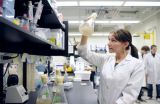(Press-News.org) Boston, Mass. – In a move aimed at bolstering current systems for assessing and monitoring drug safety, researchers at Children's Hospital Boston have created a new method that combines multiple forms of widely available data to predict adverse drug reactions. Unlike current approaches, which rely on detecting evidence of drug safety issues as they accumulate over time in clinical databases, this new method may be able to identify issues years in advance.
This study, led by Aurel Cami, PhD, and Ben Reis, PhD, of Children's Hospital Boston's Informatics Program (CHIP), appeared online December 21 in Science Translational Medicine.
The safety of drugs in the market is currently assessed through a combination of adverse drug event (ADE) reporting and data mining tools designed to detect previously unrecognized drug-ADEs relationships. While generally effective, these methods may not be able to flag the presence of certain types of ADEs until patients have been on the drug for some time.
Because of these limitations, it can take years before physicians and regulators accumulate enough data to recognize serious safety problems with a particular drug and take appropriate action.
To help address these delays and the public health risks associated with them, Reis and Cami set out to create a mathematical model for predicting drug-ADE relationships that might likely appear within a few years of a drug's entry into the market.
"This approach allows us to make the important transition from detection to prediction," said Reis, who leads the Predictive Medicine Group within CHIP. "We can potentially identify a dangerous drug side effect early on, instead of having to wait for sufficiently many patients to be affected by it in order to allow for detection."
"Given the myriad of entities and complex relationships that exist in the pharmacological domain, we felt that a network-based approach would be a promising way to try to predict unforeseen but likely adverse events," said Cami, an instructor in CHIP. "For the approach to be properly validated, though, we knew we needed to use historical and current data on drug ADEs."
To test the network, Reis and Cami integrated information from a commercially available drug safety database from Lexicomp with data on drug chemistry and information on drug and ADE taxonomy. They then took a snapshot of 809 drugs and 852 kinds of adverse events associated with those drugs in the Lexicomp data in 2005. Using the network model, they generated a list of predicted drug-ADE relationships and compared that list to a second snapshot of the Lexicomp database from 2010.
The researchers found the network model to be quite effective at predicting drug-ADE relationships that were absent in the 2005 snapshot but present in that from 2010. For instance, based only on data available in 2005, the model correctly identified 42 percent of the drug-ADE relationships that were subsequently discovered between 2006 and 2010, while correctly recognizing as false 95 percent of drug-ADE pairs that in the 2010 data were categorized as having no association.
"We think the approach holds real promise for strengthening efforts to identify and manage drug risks by helping drug safety practitioners predict high likelihood events and guide efforts to understand, avoid, and alleviate those events before they start appearing in patients," Cami said. "We're now working to extend these methods to incorporate additional sources of drug safety data and to promote their adoption in clinical drug safety practice."
"Today we rely mainly on post-marketing surveillance to identify unknown drug ADEs, especially with novel drug classes," said Shannon Manzi, PharmD, a pharmacist in the Children's Hospital Boston's Emergency Department and co-author on the study. "It would be impossible for drug companies to test every possible drug-ADE combination, so many unknown relationships surface only after the drug is introduced in the market."
"Being able to predict a potential relationship that was not previously considered," she continued, "will improve the safety of drugs as they come to market, benefiting both drug companies and patients."
###The study was funded by the National Library of Medicine and the National Institute of General Medical Sciences.
Children's Hospital Boston is home to the world's largest research enterprise based at a pediatric medical center, where its discoveries have benefited both children and adults since 1869. More than 1,100 scientists, including nine members of the National Academy of Sciences, 11 members of the Institute of Medicine and nine members of the Howard Hughes Medical Institute comprise Children's research community. Founded as a 20-bed hospital for children, Children's Hospital Boston today is a 395 bed comprehensive center for pediatric and adolescent health care grounded in the values of excellence in patient care and sensitivity to the complex needs and diversity of children and families. Children's also is the primary pediatric teaching affiliate of Harvard Medical School. For more information about research and clinical innovation at Children's, visit: http://vectorblog.org.
Taking a predictive approach to identifying adverse drug reactions
New mathematical method combines widely available data to potentially predict drug safety issues years earlier than currently possible
2011-12-22
ELSE PRESS RELEASES FROM THIS DATE:
Holiday Giving Is An Abiding Pledge With Pardee Homes
2011-12-22
Giving back to the communities in which it builds is a Pardee Homes tradition that takes on special meaning every holiday season, and perhaps never more so than this year. "A slow economy is hardest on the less fortunate, making useful outreach especially critical," said Mike McGee, president and chief executive officer of the LA-based homebuilder. "Our employees made exceptional efforts this year and their unfailing generosity is truly gratifying."
Pardee's holiday giving campaign was born nine years ago when company employees decided they preferred ...
UNC study could lead to a treatment for Angelman syndrome
2011-12-22
VIDEO:
Angelman syndrome is a severe neurodevelopmental disorder
caused by mutation or deletion of the maternally inherited copy of Ube3a
(blackened region of the chromosomes). The paternally inherited copy of
Ube3a is intact...
Click here for more information.
CHAPEL HILL, N.C. – Results of a new study from the University of North Carolina at Chapel Hill may help pave the way to a treatment for a neurogenetic disorder often misdiagnosed as cerebral palsy or autism.
Known ...
Astronomers discover deep-fried planets
2011-12-22
Two Earth-sized planets have been discovered circling a dying star that has passed the red giant stage. Because of their close orbits, the planets must have been engulfed by their star while it swelled up to many times its original size.
This discovery, published in the science journal Nature, may shed new light on the destiny of stellar and planetary systems, including our solar system.
When our sun nears the end of its life in about 5 billion years, it will swell up to what astronomers call a red giant, an inflated star that has used up most of its fuel. So large ...
San Diego Mold Remediation Company Offers Advanced Mold Testing
2011-12-22
Orange Restoration, based in San Diego, adds legally binding mold and hazardous material lab testing to their growing list of professional services. Testing services include air, surface and swab testing, testing or lead and/or asbestos and post remediation cleanup testing.
Nearly anyone can look at a black spot on a wall or ceiling and declare, you have black mold and need to have it professionally cleaned. Few companies have the expertise to perform scientific testing to confirm both the type and quantity of the contamination being observed.
Orange Restoration's ...
Discovery of 2 Earth-size planets raises questions about the evolution of stars
2011-12-22
This press release is available in French.
University of Toulouse and University of Montreal researchers have detected two planets of sizes comparable to Earth orbiting around an old star that has just passed the red giant stage. This planetary system is located near Lyra and Cygnus constellations at a distance of 3900 light years. This discovery, to be published by in Nature on December 22 2011, may shed new light on the destiny of stellar and planetary systems.
"The two planets, named KOI 55.01 and KOI 55.02, are on very short orbits around their host star," explained ...
Researchers develop new method of cleaning toxins from the oilsands
2011-12-22
Alberta's oilsands have water challenges. Oilsands development uses a vast amount of water and even though it's recycled multiple times, the recycling concentrates the toxins and metals leftover from extracting and upgrading the bitumen, resulting in tailings ponds that are both a lightening rod for controversy and a significant risk to the environment. A research project underway between biologists at the University of Calgary and engineers at the University of Alberta to help resolve the water issue is making rapid progress toward that goal.
Two years into the research, ...
Clarke BEXT Pro Portable Extractor Delivers Superior Cleaning Power with Enhanced Cleaning Flexibility
2011-12-22
Clarke, a brand of Nilfisk-Advance, Inc., introduces the latest addition to the company's line of carpet extractors, the BEXT Pro Portable Extractor. Delivering instant, continuous heat of 212 degrees Fahrenheit solution, the BEXT Pro effectively attacks tough carpet stains. The BEXT Pro is available in two pressures--100 psi and 400 psi--in addition to models with heated and non-heated performance, providing operators with the ultimate cleaning flexibility to satisfy applications ranging from light duty cleaning to deep extraction requirements.
With a durable, user-friendly ...
Exploiting Trichoderma: From food security to biotechnology
2011-12-22
From improving food security to their use as biotechnology power horses, Trichoderma fungi are increasingly being exploited by industry. Current advances in the field are brought together and highlighted in a special issue of Microbiology published online on 27 December.
Trichoderma are free-living fungi widely used in agricultural biotechnology. Some species of Trichoderma are specifically used as biocontrol agents to control plant pathogens including Fusarium species. Their success is partly due to mycoparasitism – a lifestyle where one fungus is parasitic on another ...
Self-regulation of the immune system suppresses defense against cancer
2011-12-22
It is vital that the body's own immune system does not overreact. If its key players, the helper T cells, get out of control, this can lead to autoimmune diseases or allergies. An immune system overreaction against infectious agents may even directly damage organs and tissues.
Immune cells called regulatory T cells ("Tregs") ensure that immune responses take place in a coordinated manner: They downregulate the dividing activity of helper T cells and reduce their production of immune mediators. "This happens through direct contact between regulatory cell and helper cell," ...
Balancing the womb
2011-12-22
New research hopes to explain premature births and failed inductions of labour. The study by academics at the University of Bristol suggests a new mechanism by which the level of myosin phosphorylation is regulated in the pregnant uterus.
The researchers, Dr Claire Hudson and Professor Andrés López Bernal in the School of Clinical Sciences and Dr Kate Heesom in the University Proteomics Facility and the School of Biochemistry, have discovered that phosphorylation of uterus proteins at specific amino acids have a key role in the regulation of uterine activity in labour.
A ...
LAST 30 PRESS RELEASES:
Numbers in our sights affect how we perceive space
SIMJ announces global collaborative book project in commemoration of its 75th anniversary
Air pollution exposure and birth weight
Obstructive sleep apnea risk and mental health conditions among older adults
How talking slows eye movements behind the wheel
The Ceramic Society of Japan’s Oxoate Ceramics Research Association launches new international book project
Heart-brain connection: international study reveals the role of the vagus nerve in keeping the heart young
Researchers identify Rb1 as a predictive biomarker for a new therapeutic strategy in some breast cancers
Survey reveals ethical gaps slowing AI adoption in pediatric surgery
Stimulant ADHD medications work differently than thought
AI overestimates how smart people are, according to HSE economists
HSE researchers create genome-wide map of quadruplexes
Scientists boost cell "powerhouses" to burn more calories
Automatic label checking: The missing step in making reliable medical AI
Low daily alcohol intake linked to 50% heightened mouth cancer risk in India
American Meteorological Society announces Rick Spinrad as 2026 President-Elect
Biomass-based carbon capture spotlighted in newly released global climate webinar recording
Illuminating invisible nano pollutants: advanced bioimaging tracks the full journey of emerging nanoscale contaminants in living systems
How does age affect recovery from spinal cord injury?
Novel AI tool offers prognosis for patients with head and neck cancer
Fathers’ microplastic exposure tied to their children’s metabolic problems
Research validates laboratory model for studying high-grade serous ovarian cancer
SIR 2026 delivers transformative breakthroughs in minimally invasive medicine to improve patient care
Stem Cell Reports most downloaded papers of 2025 highlight the breadth and impact of stem cell research
Oxford-led study estimates NHS spends around 3% of its primary and secondary care budget on the health impacts of heat and cold in England
A researcher’s long quest leads to a smart composite breakthrough
Urban wild bees act as “microbial sensors” of city health.
New study finds where you live affects recovery after a hip fracture
Forecasting the impact of fully automated vehicle adoption on US road traffic injuries
Alcohol-related hospitalizations from 2016 to 2022
[Press-News.org] Taking a predictive approach to identifying adverse drug reactionsNew mathematical method combines widely available data to potentially predict drug safety issues years earlier than currently possible



